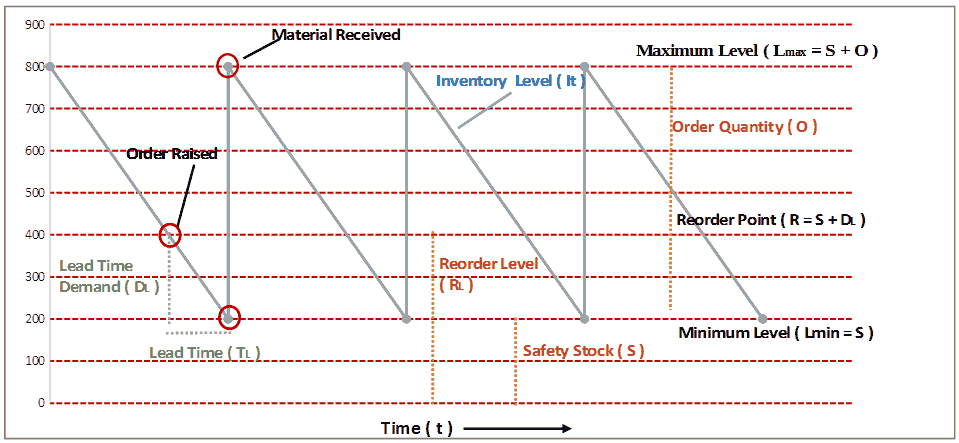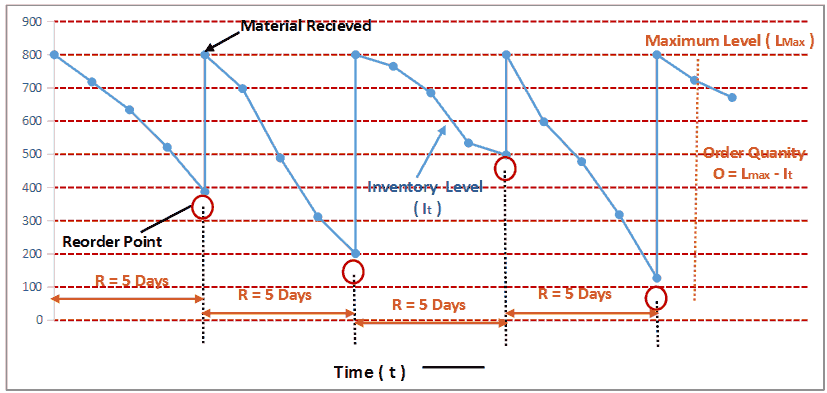

Inventory also referred as stocks are basically the goods and raw materials that any business would hold and are ready or will be ready for sale.
Fixed Reorder Quantity System is an Inventory Model, where an alarm is raised immediately when the inventory level drops below a fixed quantity and new orders are raised to replenish the inventory to an optimum level based on the demand. The point at which the inventory is ordered for replenishment is termed as Reorder Point. The inventory quantity at Reorder Point is termed as Reorder Level and the quantity of new inventory ordered is referred as Order Quantity.
Average Demand (DAv): It is the average number of order requests made per day.
Average Lead Time (TL): The time required to manufacture goods or product.
Average Lead Time Demand (DL): Average number of orders requested during the Lead Time
Average Lead Time Demand (DL) = Average Demand (DAv) X Average Lead Time (TL)
Safety Stock (S): It is the extra stock that is always maintained to mitigate any future risks arising due to stock-outs because of shortfall of raw materials or supply, breakdown in machine or plant, accidents, natural calamity or disaster, labour strike or any other crisis that may the stall the production process.
The quantity of safety stock is often derived by analysing historical data and is set to an optimized level by evaluating carefully the current cost of inventory and losses that may be incurred due to future risk.
Reorder Level (RL): Reorder level is the inventory level, at which an alarm is triggered immediately to replenish that particular inventory stock. Reorder level is defined, keeping into consideration the Safety Stock to avoid any stock-out and Average Lead Time Demand because even after raising the alarm, it would take one complete process cycle (Lead Time) till the new inventories arrive to replenish the existing inventory.
Reorder Level (RL) = Safety Stock (S) + Average Lead Time Demand (DL)
Order Quantity (O): Order quantity is the Demand (Order requests) that needs to be delivered to the customer.
Minimum Level: At least Safety Stock has to be always maintained to avoid any future stock- outs as per the standard practices of inventory management.
Minimum Level (LMin) = Safety Stock (S)
Maximum Level: The maximum level that can be kept in stock is safety stock and the demand (the quantity ordered).
Maximum Level (LMax) = Safety Stock (S) + Order Quantity (O)

Figure 1: Inventory Model: Fixed Reorder Quantity System
Example: The order quantity of an Item is 600 Units. The safety Stock is 200 Units. The Average Lead Time is 5 Days and average consumption per days is 40 units.
Order Quantity (O) = 600 Units
Safety Stock (S) = 200 Units
Average Lead Time (TL) = 5 Days
Average Demand ( DAv ) = 40 Units
Average Lead Time Demand (DL) = Demand (DAv) X Lead Time (TL) = 200 Units
Reorder Level (RL) = Safety Stock (S) + Average Lead Time Demand (DL) = 400 Units
Minimum Level (LMin) = Safety Stock (S) = 200 Units
Maximum Level (LMax) = Safety Stock (S) + Order Quantity (O) = 800 Units
Fixed Reorder Period System is an Inventory Model of managing inventories, where an alarm is raised after every fixed period of time and orders are raised to replenish the inventory to an optimum level based on the demand. In this case replenishment of inventory is a continuous process done after every fixed interval of time.
Regular Intervals (R): Regular Interval is the fixed time interval at the end of which the inventories would be reviewed and orders would be raised to replenish the inventory
Inventory on Hand (It): Inventory on hand is the Inventory level measured at any given point of time.
Maximum Level (M): It is the maximum level of inventory allowed as per the production guidelines. The maximum level is derived by analysing historical data.
Order Quantity: In this system, inventory is reviewed at regular intervals (R), inventory on hand (It) is noted at the time of review and order quantity is placed for a quantity of (M) – (It).
Order Quantity (O) = (M) – (It).

Figure 1: Inventory Model: Fixed Reorder Period System
Example: Inventory is replenished at every regular interval of 5 days. The maximum allowable inventory is 800 Units. The inventory reviewed on Day-5, Day-10, Day -15 and Day -20 were 387 Units, 201 Units, 498 Units and 127 Units respectively.
Regular Intervals (R) = 5 Days
Maximum Level (M) = 800 Units
Inventory on Hand: I5 = 387 Units, I10 = 201 Units, I15 = 498 Units and I20 = 127 Units
Order Quantity (O) = (M) – (It).
Order Quantity (O5) = 800 – 387 = 413 Units
Order Quantity (O10) = 800 – 201 = 599 Units
Order Quantity (O15) = 800 – 498 = 302 Units
Order Quantity (O15) = 800 – 127 = 673 Units